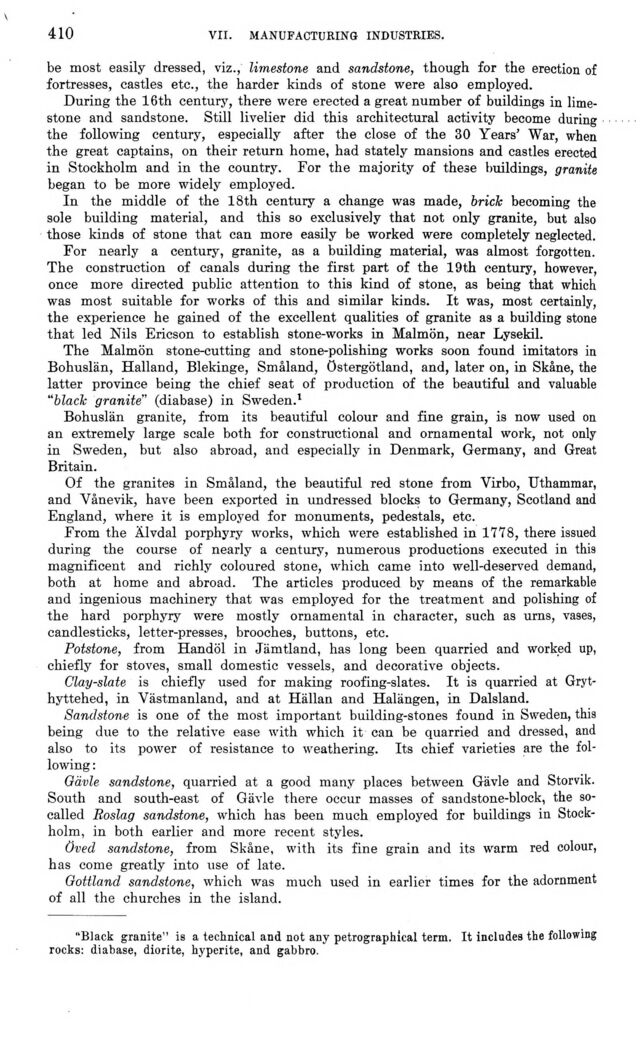
Full resolution (JPEG) - On this page / på denna sida - VII. Manufacturing Industries. Introd. by [G. Sundbärg] K. Åmark - 8. Manufactures of Stone, Clay, Coal, Charcoal, and Peat - Stone Industry. By E. Svedmark

<< prev. page << föreg. sida << >> nästa sida >> next page >>
Below is the raw OCR text
from the above scanned image.
Do you see an error? Proofread the page now!
Här nedan syns maskintolkade texten från faksimilbilden ovan.
Ser du något fel? Korrekturläs sidan nu!
This page has never been proofread. / Denna sida har aldrig korrekturlästs.
\
410
vii. manufacturing industries.
be most easily dressed, viz., limestone and sandstone, though for the erection of
fortresses, castles etc., the harder kinds of stone were also employed.
During the 16th century, there were erected a great number of buildings in
limestone and sandstone. Still livelier did this architectural activity become during
the following century, especially after the close of the 30 Years’ War, when
the great captains, on their return home, had stately mansions and castles erected
in Stockholm and in the country. For the majority of these buildings, granite
began to be more widely employed.
In the middle of the 18th century a change was made, brick becoming the
sole building material, and this so exclusively that not only granite, but also
those kinds of stone that can more easily be worked were completely neglected.
For nearly a century, granite, as a building material, was almost forgotten.
The construction of canals during the first part of the 19th century, however,
once more directed public attention to this kind of stone, as being that which
was most suitable for works of this and similar kinds. It was, most certainly,
the experience he gained of the excellent qualities of granite as a building stone
that led Nils Ericson to establish stone-works in Malmön, near Lysekil.
The Malmön stone-cutting and stone-polishing works soon found imitators in
Bohuslän, Halland, Blekinge, Småland, Östergötland, and, later on, in Skåne, the
latter province being the chief seat of production of the beautiful and valuable
"black granite" (diabase) in Sweden.1
Bohuslän granite, from its beautiful colour and fine grain, is now used on
an extremely large scale both for constructional and ornamental work, not only
in Sweden, but also abroad, and especially in Denmark, Germany, and Great
Britain.
Of the granites in Småland, the beautiful red stone from Virbo, Uthammar,
and Vånevik, have been exported in undressed blocks to Germany, Scotland and
England, where it is employed for monuments, pedestals, etc.
From the Älvdal porphyry works, which were established in 1778, there issued
during the course of nearly a century, numerous productions executed in this
magnificent and richly coloured stone, which came into well-deserved demand,
both at home and abroad. The articles produced by means of the remarkable
and ingenious machinery that was employed for the treatment and polishing of
the hard porphyry were mostly ornamental in character, such as urns, vases,
candlesticks, letter-presses, brooches, buttons, etc.
Potstone, from Handöl in Jämtland, has long been quarried and worked up,
chiefly for stoves, small domestic vessels, and decorative objects.
Clay-slate is chiefly used for making roofing-slates. It is quarried at
Gryt-hyttehed, in Västmanland, and at Hällan and Halängen, in Dalsland.
Sandstone is one of the most important building-stones found in Sweden, this
being due to the relative ease with which it can be quarried and dressed, and
also to its power of resistance to weathering. Its chief varieties are the
following :
Gävle sandstone, quarried at a good many places between Gävle and Storvik.
South and south-east of Gävle there occur masses of sandstone-block, the
so-called Roslag sandstone, which has been much employed for buildings in
Stockholm, in both earlier and more recent styles.
Öved sandstone, from Skåne, with its fine grain and its warm red colour,
has come greatly into use of låte.
Gottland sandstone, which was much used in earlier times for the adornment
of all the churches in the island.
"Black granite" is a technical and not any petrographical term. It includes the following
rocks: diabase, diorite, hyperite, and gabbro.
<< prev. page << föreg. sida << >> nästa sida >> next page >>